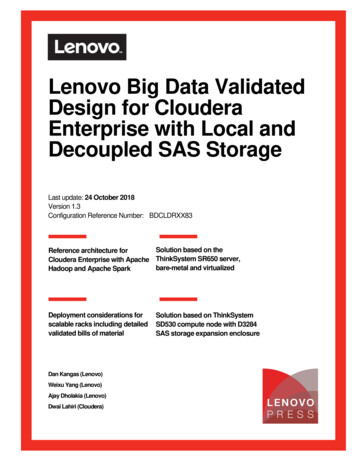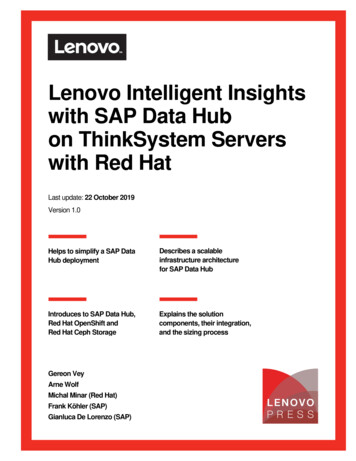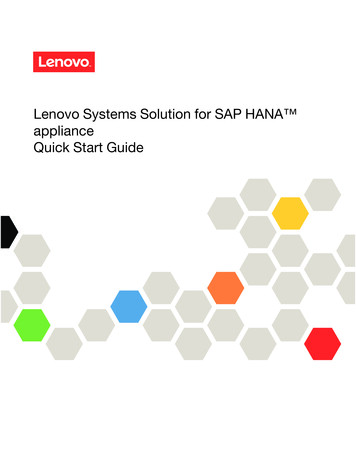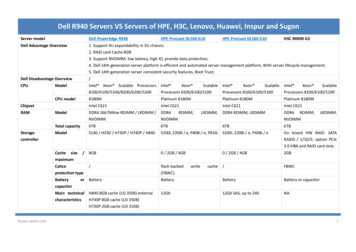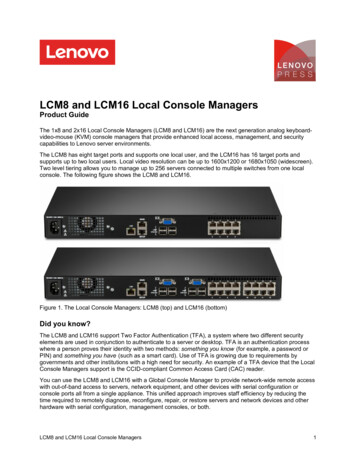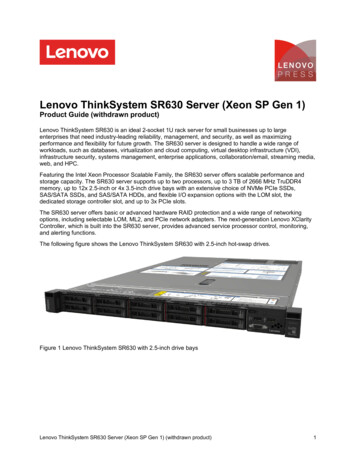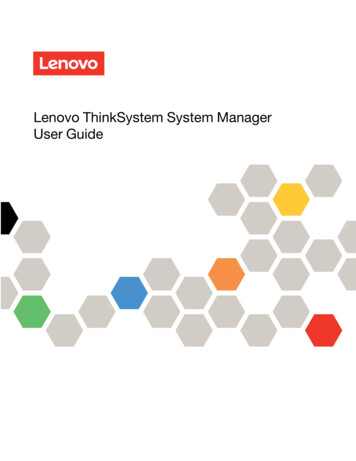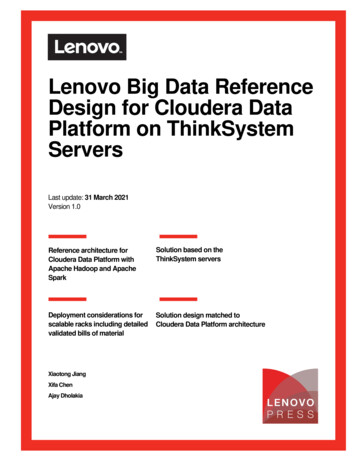
Transcription
Lenovo Big Data ReferenceDesign for Cloudera DataPlatform on ThinkSystemServersLast update: 31 March 2021Version 1.0Reference architecture forCloudera Data Platform withApache Hadoop and ApacheSparkSolution based on theThinkSystem serversDeployment considerations forscalable racks including detailedvalidated bills of materialSolution design matched toCloudera Data Platform architectureXiaotong JiangXifa ChenAjay DholakiaClick here to check for updates1Lenovo Big Data Reference Design for Cloudera Data Platform on ThinkSystem Servers
Table of Contents1Introduction . 42Business problem and business value. 53Requirements . 73.1Functional Requirements . 73.2Non-functional Requirements. 74Architectural Overview . 84.1Cloudera Data Platform . 84.2CDP Private Cloud . 85Component Model . 105.16Cloudera Components . 11Operational Model . 156.1Lenovo Server Description . 156.1.1Processor Selection . 156.1.2Memory Size and Performance . 166.1.3Estimating Disk Space . 166.2Cluster Node Configurations . 176.2.1Worker Nodes . 176.2.2Master and Utility Nodes . 186.2.3System Management and Gateway Nodes . 196.2.4OpenShift Cluster Nodes for CDP Private Cloud Experiences . 196.3Cluster Software Stack . 206.3.0Cloudera Data Platform CDP . 206.3.1HDFS and Ozone . 206.4Cloudera Service Role Layouts. 206.5System Management . 226.6Networking . 2326.6.0Data Network . 246.6.1Hardware Management Network . 256.6.2Multi-rack Network . 25Lenovo Big Data Reference Design for Cloudera Data Platform on ThinkSystem Servers
6.77Predefined Cluster Configurations . 27Resources . 28Document history . 303Lenovo Big Data Reference Design for Cloudera Data Platform on ThinkSystem Servers
1 IntroductionThis document describes the reference design for Cloudera Data Platform software on ThinkSystem servers.It provides architecture guidance for designing optimized hardware infrastructure for the Cloudera DataPlatform Private Cloud edition, a distribution of Apache Hadoop and Apache Spark with enterprise-readycapabilities from Cloudera. This reference design provides the planning, design considerations, and bestpractices for implementing Cloudera Data Platform with Lenovo products.Lenovo and Cloudera worked together on this document, and the reference architecture that is describedherein was validated by Lenovo and Cloudera.With the ever-increasing volume, variety and velocity of data becoming available to an enterprise comes thechallenge of deriving the most value from it. This task requires the use of suitable data processing andmanagement software running on a tuned hardware platform. With Apache Hadoop and Apache Sparkemerging as popular big data storage and processing frameworks, enterprises are building so-called DataLakes by employing these components.Cloudera brings the power of Hadoop to the customer's enterprise. Hadoop is an open source softwareframework that is used to reliably manage large volumes of structured and unstructured data. Clouderaexpands and enhances this technology to withstand the demands of your enterprise, adding management,security, governance, and analytics features. The result is that you get a more enterprise ready solution forcomplex, large-scale analytics.The intended audience for this reference architecture is IT professionals, technical architects, salesengineers, and consultants to assist in planning, designing, and implementing the big data solution withLenovo hardware. It is assumed that you are familiar with Hadoop components and capabilities. For moreinformation about Hadoop, see “Resources” on page 28.4Lenovo Big Data Reference Design for Cloudera Data Platform on ThinkSystem Servers
2 Business problem and business valueBusiness ProblemThe world is well on its way to generate 175 ZB of data by 2025. This is a 61% CAGR compare to 33 ZB ofdata in 2018. This data comes from everywhere, including sensors that are used to gather climateinformation, posts to social media sites, digital pictures and videos, purchase transaction records, and cellphone global positioning system (GPS) signals. This data is big data.Big data spans the following dimensions: Volume: Big data comes in one size: large – in size, quantity and/or scale. Enterprises are awash withdata, easily amassing terabytes and even petabytes of information. Velocity: Often time-sensitive, big data must be used as it is streaming into the enterprise to maximizeits value to the business. Variety: Big data extends beyond structured data, including unstructured data of all varieties, such astext, audio, video, click streams, and log files.Enterprises are incorporating large data lakes into their IT architecture to store all their data. The expectationis that ready access to all the available data can lead to higher quality of insights obtained through the use ofanalytics, which in turn drive better business decisions. A key challenge faced today by these enterprises issetting up an easy to deploy data storage and processing infrastructure that can start to deliver the promisedvalue in a very short amount of time. Spending months of time and hiring dozens of skilled engineers to piecetogether a data management environment is very costly and often leads to frustration from unrealized goals.Furthermore, the data processing infrastructure needs to be easily scalable in addition to achieving desiredperformance and reliability objectives.Big data is more than a challenge; it is an opportunity to find insight into new and emerging types of data tomake your business more agile. Big data also is an opportunity to answer questions that, in the past, werebeyond reach. Until now, there was no effective way to harvest this opportunity. Today, Cloudera uses thelatest big data technologies such as the in-memory processing capabilities of Spark in addition to the standardMapReduce scale-out capabilities of Hadoop, to open the door to a world of possibilities.Business ValueHadoop is an open source software framework that is used to reliably manage and analyze large volumes ofstructured and unstructured data. Cloudera enhances this technology to withstand the demands of yourenterprise, adding management, security, governance, and analytics features. The result is that you get anenterprise-ready solution for complex, large-scale analytics.How can businesses process tremendous amounts of raw data in an efficient and timely manner to gainactionable insights? Cloudera allows organizations to run large-scale, distributed analytics jobs on clusters ofcost-effective server hardware. This infrastructure can be used to tackle large data sets by breaking up thedata into “chunks” and coordinating data processing across a massively parallel environment. After the rawdata is stored across the nodes of a distributed cluster, queries and analysis of the data can be handledefficiently, with dynamic interpretation of the data formatted at read time. The bottom line: Businesses canfinally get their arms around massive amounts of untapped data and mine that data for valuable insights in amore efficient, optimized, and scalable way.5Lenovo Big Data Reference Design for Cloudera Data Platform on ThinkSystem Servers
Cloudera that is deployed on Lenovo ThinkSystem servers provides excellent price/performance. Thereference architecture supports entry through high-end configurations and the ability to easily scale as the useof big data grows. A choice of infrastructure components provides flexibility in meeting varying big dataanalytics requirements.6Lenovo Big Data Reference Design for Cloudera Data Platform on ThinkSystem Servers
3 RequirementsThe functional and non-functional requirements for this reference architecture are desribed in this section.Functional RequirementsA big data solution supports the following key functional requirements: Ability to handle various workloads, including batch and real-time analytics Industry-standard interfaces so that applications can work with Cloudera Ability to handle large volumes of data of various data types Various client interfacesNon-functional RequirementsCustomers require their big data solution to be easy, dependable, and fast. The following non-functionalrequirements are key: 7Easy:oEase of developmentoEasy management at scaleoAdvanced job managementoMulti-tenancyoEasy to access data by various user typesDependable:oData protection with snapshot and mirroringoAutomated self-healingoInsight into software/hardware health and issuesoHigh availability (HA) and business continuityFast:oSuperior performanceoScalabilitySecure and governed:oStrong authentication and authorizationoKerberos supportoData confidentiality and integrityLenovo Big Data Reference Design for Cloudera Data Platform on ThinkSystem Servers
4 Architectural OverviewCloudera Data PlatformFigure 1 shows the high-level architecture of the Cloudera data platform that consists of CDP private cloudbuilt on Lenovo hardware and CDP public cloud running on public clouds. CDP private cloud is built forhybrid cloud, seamlessly connecting on-premises environments to public clouds with consistent, built-insecurity and governance. CDP Public Cloud is a cloud form factor of CDP. Cloudera SDX (Shared DataExperience) secure and govern platform data and metadata as well as control capabilities. Data security,governance, and control policies are set once and consistently enforced everywhere, reducing operationalcosts and business risks while also enabling complete infrastructure choice and flexibility.Figure 1. Cloudera Data Platform architecture overviewCDP Private CloudCloudera Data Platform (CDP) Private Cloud is the newest on-premises version of CDP that brings manybenefits of the public cloud services to the on-premises deployment.CDP Private Cloud provides a disaggregation of compute and storage, and allows independent scaling ofcompute and storage clusters. CDP Private Cloud gets unified security, governance, and metadatamanagement through Cloudera SDX.CDP Private Cloud users can rapidly provision and deploy Cloudera Data Warehousing and ClouderaMachine Learning services through the Management Console, and easily scale them up or down as required.Figure 2 shows a CDP Private Cloud deployment. It requires you to have a Private Cloud Base cluster and aPrivate Cloud Experiences cluster deployed on a RedHat OpenShift cluster. Both Private Cloud Base cluster8Lenovo Big Data Reference Design for Cloudera Data Platform on ThinkSystem Servers
and the OpenShift cluster are set up on Lenovo servers. The Private Cloud deployment process involvesconfiguring Management Console on the OpenShift cluster, registering an environment by providing details ofthe Data Lake configured on the Base cluster, and then creating the workloads.The Cloudera Private Cloud Base is comprised of a variety of components such as Apache HDFS,Apache OZone, Apache Spark, and Apache Impala, along with many other components for specializedworkloads. You can select any combination of these services to create clusters that address yourbusiness requirements and workloads. CDP Private Cloud Base solutions described in this document canbe deployed on bare-metal infrastructure. This means that both the management nodes and the data nodesare implemented on physical hosts. The number of servers of each type is determined based on requirementsfor high-availability, total data capacity and desired performance objectives. This reference design providesvalidated solutions for traditional local storage on the Lenovo server, configured for non-RAID JBOD (Just-aBunch-Of-Drives) which gives over 40% more storage capacity per rack and more compute nodes comparedto nodes with internal HDD storage.With Hadoop local storage, Lenovo server contains compute and storage in the same physical enclosure.Scale out is accomplished by adding one or more nodes which add both compute and storage simultaneouslyto the cluster. The Lenovo server provides the highest CPU core count and highest total memory per node fora very high-end analytics solution.Figure 2. CDP Private CloudCloudera Private Cloud base provides several interfaces that allow administrators and users to performadministration and data functions, depending on their roles and access level. Hadoop applicationprogramming interfaces (APIs) can be used to access data. Cloudera APIs can be used for clustermanagement and monitoring. Cloudera data services, management services, and other services run on thenodes in cluster. Storage is a component of each data node in the cluster. Data can be incorporated intoCloudera Data Platform storage through the Hadoop APIs, depending on the needs of the customer.9Lenovo Big Data Reference Design for Cloudera Data Platform on ThinkSystem Servers
5 Component ModelCloudera Data Platform provides features and capabilities that meet the functional and nonfunctionalrequirements of customers. It supports mission-critical and real-time big data analytics across differentindustries, such as financial services, retail, media, healthcare, manufacturing, telecommunications,government organizations, and leading Fortune 100 and Web 2.0 companies.Cloudera Data Platform is the world’s most complete, tested, and popular distribution of Apache Hadoop andrelated projects. All of the packaging and integration work is done for you, and the entire solution is thoroughlytested and fully documented. By taking the guesswork out of building out your Hadoop deployment, ClouderaData Platform gives you a streamlined path to success in solving real business problems with big data.The Cloudera platform for big data can be used for various use cases from batch applications that useMapReduce or Spark with data sources, such as click streams, to real-time applications that use sensor data.Figure 3 shows the Cloudera Data Platform that meet the functional requirements of customers.Figure 3. Cloudera Data Platform overview10Lenovo Big Data Reference Design for Cloudera Data Platform on ThinkSystem Servers
Cloudera ComponentsCloudera Data Platform solution contains the following components: Analytic SQL: Apache ImpalaImpala is the industry’s leading massively parallel processing (MPP) SQL query engine that runsnatively in Hadoop. Apache-licensed, open source Impala project combines modern, scalable paralleldatabase technology with the power of Hadoop, enabling users to directly query data stored in HDFSand Apache HBase without requiring data movement or transformation. Impala is designed from theground up as part of the Hadoop system and shares the same flexible file and data formats,metadata, security, and resource management frameworks that are used by MapReduce, ApacheHive and other components of the Hadoop stack. Search Engine: Cloudera SearchCloudera Search is Apache Solr fully integrated in the Cloudera platform, taking advantage of theflexible, scalable, and robust storage system and data processing frameworks included in ClouderaData Platform (CDP). This eliminates the need to move large data sets across infrastructures toperform business tasks. It further enables a streamlined data pipeline, where search and textmatching is part of a larger workflow. Cloudera Search also includes valuable integrations that makesearching more scalable, easy to use, and optimized for near-real-time and batch-oriented indexing.These integrations include Cloudera Morphlines, which is a customizable transformation chain thatsimplifies loading any type of data into Cloudera Search. NoSQL - HBaseA scalable, distributed column-oriented datastore. HBase provides real-time read/write randomaccess to very large datasets hosted on HDFS. Stream Processing: Apache SparkApache Spark is an open source, parallel data processing framework that complements Hadoop tomake it easy to develop fast, unified big data applications that combine batch, streaming, andinteractive analytics on all your data. Cloudera offers commercial support for Spark with ClouderaData Platform. Spark is 10 – 100 times faster than MapReduce which delivers faster time to insight,allows inclusion of more data, and results in better business decisions and user outcomes. Machine Learning: Spark MLlibMLlib is the API that implements common machine learning algorithms. MLlib is usable in Java,Scala, Python and R. Leveraging Spark’s excellence in iterative computation, MLlib runs very fast,high-quality algorithms. Cloudera ManagerCloudera Manager is the industry’s first and most sophisticated management application for Hadoopand the enterprise data hub. Cloudera Manager sets the standard for enterprise deployment bydelivering granular visibility into and control over every part of the data hub, which empowersoperators to improve performance, enhance quality of service, increase compliance, and reduceadministrative costs. Cloudera Manager makes administration of your enterprise data hub simple and11Lenovo Big Data Reference Design for Cloudera Data Platform on ThinkSystem Servers
straightforward, at any scale. With Cloudera Manager, you can easily de
capabilities from Cloudera. This reference design provides the planning, design considerations, and best practices for implementing Cloudera Data Platform with Lenovo products. Lenovo and Cloudera worked together on this document, and the reference architecture that is described here
